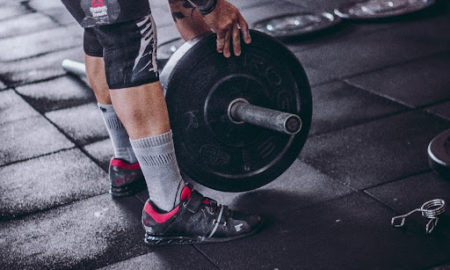Bodybuilders have known for decades that getting a massive blood-saturating “pump” and achieving the “burn” during their workouts are critical to maximizing muscular hypertrophy. Those ideas have been supported by a number of studies that show the effectiveness of training methods that maximize blood flow to the muscle and the accumulation of metabolites that cause the well-known “burn.” Such methods typically involve high training volume and short rest periods, as well as unique shocking methods such as drop sets and supersets.
An unfortunate side effect of that kind of training is the precipitous decline in performance with each passing set. Two primary mechanisms thought to underlie fatigue are the accumulation of hydrogen ions, bringing an increase in acidity, and oxidative stress. An athlete’s ability to resist fatigue is therefore critical for maintaining performance.
It’s recently been demonstrated that intramuscular carnosine is a major contributor to a muscle’s ability to resist fatigue. Carnosine has been shown to buffer hydrogen ions (and thus lower acidity), lower oxidative stress and even increase the muscles’ ability to rapidly contract.1
Carnosine is a dipeptide made by carnosine synthase from the amino acids histidine and beta-alanine. Histidine is not limited to carnosine synthesis, however. A 2006 study showed that carnosine supplementation is no more effective at increasing intramuscular carnosine than supplementation with beta-alanine alone.12 Since then, a number of studies have focused on the effectiveness of beta-alanine supplementation, and the results have been more encouraging. They have shown that beta-alanine supplementation is effective in increasing intramuscular carnosine levels—and that it corresponds with enhanced strength, power and volume per training session.2
Beta-Alanine for Resistance-Training Athletes
For resistance-training athletes, the most benefits from beta-alanine supplementation occur during exercises that stress the glycolytic energy pathway, which uses carbohydrates such as glucose for energy production and increases a number of metabolites—in particular, hydrogen ions. That occurs with moderately high repetition ranges—eight to 12 reps or 70 to 85 percent of one-repetition maximum—and multiple sets—three to five or so—coupled with 30-to-90-second rest periods between sets. Conversely, heavy training of one to five reps with rest periods of three to five minutes between sets relies primarily on immediate creatine phosphate energy production—the ATP-CP pathway—and won’t produce as many hydrogen ions.
To illustrate, 30 days of beta-alanine supplementation at 4.8 grams per day in experienced, resistance-trained men who were on a moderately high–intensity training regimen, with rest periods of 1.5 minutes between sets, led to a 22 percent increase in total repetitions per set per workout.3 Furthermore, there were significant increases in training volume for four sets—six to eight repetitions—on bench presses with individuals who were taking beta-alanine.
In contrast, a more recent 10-week study employing higher-intensity training—that is, 5, 3, 5 on squats and bench press exercises—with rest periods of up to five minutes resulted in no significant changes in strength or mass with beta-alanine supplementation.4 The main explanation for the lack of results in the second study was that the longer rest periods gave the acidity in the muscle time to clear, making extra carnosine not as beneficial as it is in protocols with shorter rest periods.
Some have theorized that the higher training volume resulting from beta-alanine supplementation may increase hormone responses during exercise; however, studies have shown no changes in hormone responses either at rest or after resistance training for growth hormone, testosterone, blood lactate, cortisol, IGF-1 or sex-hormone-binding globulin.5
Thus far, beta-alanine alone has not led to significant changes in lean-body mass. It’s possible that the outcome may be attributed to inadequate training stimulus or length of time over which studies have been conducted. A long-duration periodized strength routine may be necessary to identify accurately the effects of beta-alanine on lean-body mass.
Beta-Alanine Supplementation for Sprinting and Endurance Exercise
Sprinting and interval training have become more prominent among bodybuilders hoping to lean out. High-intensity sprinting can benefit from beta-alanine supplementation the way resistance training can, depending on the duration of exercise. For instance, a short 10-to-20-second sprint will rely on the ATP-CP energy pathway, making beta-alanine supplementation less effective, while a 30-to-90-second sprinting bout will greatly stress the glycolytic energy-and-carbohydrate pathway, in which case muscle carnosine content will be a major contributor to fatigue resistance.
In a recent study, active males were asked to cycle at 110 percent of their mean power output obtained during the final 60 seconds of an incremental cycling test to exhaustion.6 Mean cycling time to exhaustion was 156 seconds pretest and increased by 12 and 16 percent after four and 10 weeks of supplementation. Those changes paralleled an increase in intramuscular carnosine, which rose by 58 to 80 percent at weeks four and 10, respectively. Likewise, trained sprint athletes supplementing with 4.8 grams of beta-alanine daily increased average torque during the final two sets of five maximal sets of 30 isokinetic contractions.7 The sprint time on 400 meters, however, did not increase, suggesting that the event may not be limited by the hydrogen-ion-buffering capacity in highly trained sprinters. Thus, beta-alanine may prove beneficial for athletes who frequently perform high-intensity sprinting or interval training.
Beta-Alanine for Masters Bodybuilders
Although the majority of beta-alanine studies have been conducted with young men aged 20 to 29, the amino may be even more beneficial for masters-level bodybuilders. The reason is that older athletes have much less muscle carnosine, which explains in part why they generally have difficulties with fatigue.
In fact, in the elderly, beta-alanine supplementation appears to be particularly effective—older athletes supplementing with it have exhibited nearly double the increase in training capacity of their younger counterparts. That may reflect the fact that they begin with lower starting levels of intramuscular carnosine than younger populations.8,9,10
Finally, beta-alanine supplementation appears to be effective, regardless of training experience.
Optimal Doses
Human research has been limited to a range of 1.6-to-6.4-gram doses of beta-alanine daily for 28 days. Within that range, the amino appears to increase intramuscular carnosine and performance in a dose-dependent fashion.
The daily dose of beta-alanine appears to be limited by the flushing symptoms its users experience. One team of researchers found that a single 3.2-gram hit of beta-alanine resulted in paresthesia, a flushing sensation characterized by a skin-deep, prickly, irritating reaction. It radiated from the ears, scalp, upper trunk and, finally, the base of the spine.11 Although lower in severity, the symptoms were still present at half the dosage but were only mild and experienced by 25 percent of participants at 0.8-gram servings. The reason for the side effect is not completely understood, but one theory is that beta-alanine may bind to nerve receptors near the skin and increase paresthesia.
The scientists decided to dole out the full dose of beta-alanine in small increments of 0.8 grams every three hours over the course of the day because beta-alanine returns to baseline concentration after that. More recently, a controlled-release formula has been administered at 1.6 grams four times per day for four weeks to reduce flushing symptoms.13 No symptoms of paresthesia were reported at that dose.
Summing It Up
Critical to a successful training session is the body’s ability to recover from and prevent fatigue so that more work can be performed. Recent research has identified carnosine—a dipeptide composed of beta-alanine and histidine—as a powerful hydrogen ion buffer that delays fatigue. Histidine does not appear to be limiting for carnosine synthesis; therefore, a number of studies have investigated the effectiveness of beta-alanine supplementation.
The results: Beta-alanine supplementation leads to increased intramuscular carnosine and corresponding increases in strength, power, training volume and endurance. Benefits are maximized when stressing the glycolytic energy system. For bodybuilders, that occurs with moderately high-repetition ranges—eight to 12 reps or 70 to 85 percent of one-rep maximum—and three to five or more sets, coupled with between-set rests of 30 to 90 seconds. For high-intensity interval training, it occurs with sprints of 30 to 120 seconds in duration.
Editor’s note: Gabriel Wilson is a Ph.D candidate in nutrition at the University of Illinois, Urbana-Champaign, and is researching optimal protein requirements for muscle growth. He’s also vice president of ABCbodybuilding.com. Jacob Wilson, Ph.D., is a professor of exercise science and researcher in the Department of Exercise and Sports Sciences at the University of Tampa, Florida. He’s president of ABCbodybuilding.com.
References
1 Skulachev, V.P. (2000). Biological role of carnosine in the functioning of excitable tissues. Centenary of Gulewitsch’s discovery. Biochem (Mosc). 65:749–750.
2 Wilson, J.M., Wilson, G.J., et al. (2010). Beta-alanine supplementation improves aerobic and anaerobic indices of performance. Strength and Cond J. 32(1):71-78.
3 Hoffman, J.R., et al. (2008). Short-duration beta-alanine supplementation increases training volume and reduces subjective feelings of fatigue in college football players. Nutr Res. 28:31-35.
4 Kendrick, I.P., et al. (2008). The effects of 10 weeks of resistance training combined with beta-alanine supplementation on whole body strength, force production, muscular endurance and body composition. Amino Acids. 34:547-554.
5 Hoffman, J., et al. (2006). Effect of creatine and beta-alanine supplementation on performance and endocrine responses in strength/power athletes. Int J Sport Nutr Exerc Metab. 16:430-446.
6 Hill, C.A., et al. (2007). Influence of beta-alanine supplementation on skeletal muscle carnosine concentrations and high intensity cycling capacity. Amino Acids. 32(2):225-33.
7 Derave, W., et al. (2007). Beta-alanine supplementation augments muscle carnosine content and attenuates fatigue during repeated isokinetic contraction bouts in trained sprinters. J Appl Physiol. 103: 1736-1743.
8 Stout, J.R., et al. (2006). Effects of 28 days of beta-alanine and creatine monohydrate supplementation on the physical working capacity at neuromuscular fatigue threshold. J Strength Cond Res. 20:928-931.
9 Stout, J.R., et al. (2007). Effects of beta-alanine supplementation on the onset of neuromuscular fatigue and ventilatory threshold in women. Amino Acids. 32: 381-386.
10 Stout, J.R., et al. (2008). The effect of beta-alanine supplementation on neuromuscular fatigue in elderly (55–92 years): A double-blind randomized study. J Int Soc Sports Nutr. 5:21.
12 Harris, R.C., et al. (2006). The absorption of orally supplied beta-alanine and its effect on muscle carnosine synthesis in human vastus lateralis. Amino Acids. 30:279-289.
13 Zoeller, R.F., et al. (2007). Effects of 28 days of beta- alanine and creatine monohydrate supplementation on aerobic power, ventilatory and lactate thresholds, and time to exhaustion. Amino Acids. 33:505-510. IM
















You must be logged in to post a comment Login